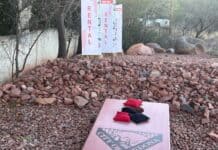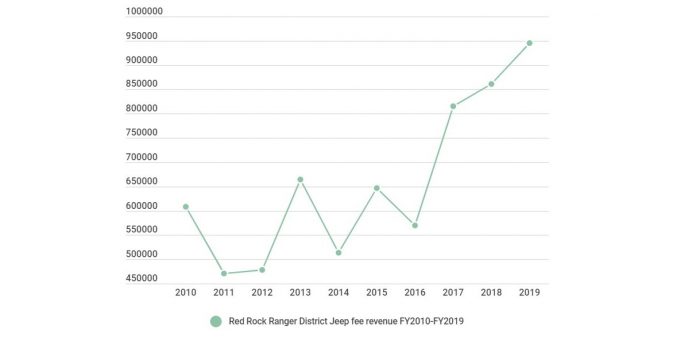Between 2016 and 2019, commercial permit revenues from guided Jeep tours in the Red Rock Ranger District grew 65%, helping push the district’s total annual revenue from commercial permit fees above $1 million for the federal fiscal year that ended Sept. 30, 2019.
This was the first time in district history that the combined fees from the various commercial permittees crossed the $1 million mark. That figure does not include revenue from the Red Rock Pass, a local trailhead parking permit.
For Julie Rowe, recreation special uses program manager for the Red Rock Ranger District, the $1 million benchmark represents years of developing the administrative infrastructure of the U.S. Forest Service’s permit programs and improving relationships with commercial operators.
“Ten years ago the relationship between the Forest [Service] and guides was very acrimonious,” Rowe said, adding that reaching the new benchmark represents “how much we’ve turned that around.”
The World Bank recently included the Red Rock Ranger District’s outfitter/ guide permit program in a publication highlighting eight worldwide case studies of “Stimulating Sustainable Development through Tourism Concessions.” The report detailed the way permit programs are established in the district and how the partnership between the guides and the Red Rock Ranger District works.
The revenue from permits helps the USFS manage the high intensity of visitation in the Red Rock Ranger District, but Rowe said creating permit programs is not about generating funds for the USFS.
“We don’t really think about revenue. We think about services to the public,” Rowe said. “I don’t issue guide permits because I want to hit $1.2 million. We issue permits because there is a need.”
Dave Swartwout, owner of Arizona Safari Jeep Tours, expressed satisfaction with the permit program.
“I think that they administer well and it’s a good program for the public,” Swartwout said. “It ensures that the companies have insurance and are safe and get inspections.”
Jeep Tours are Largest Partners 
All commercial outfitter/ guide permittees pay the USFS 3% of gross revenue. According to data provided by the Red Rock Ranger District, the fees paid by guided Jeep tours dwarf all other permitted commercial activity in the district.
Guided Jeep tour permittees paid the Red Rock Ranger District $945,378 in 2019. That’s up from $860K in 2018 and $815K in 2017, a year that marked a significant leap in Jeep tour revenues from the previous year [$569,762], which was more typical of the previous seven years.
The next-largest revenue generator in the same period was hot air ballooning, which paid approximately $65,000 in fees.
The bump in USFS fees from Jeep tour permits in 2017 tracks with a bump in sales tax revenue collected by the city of Sedona that year, but the Jeep tour growth appears to be modestly outperforming the city’s overall economic growth. Between 2016 and 2019, city sales tax receipts grew 44% [boosted by a 0.5% tax increase in FY18] compared to the 65% growth in Jeep tour fees over roughly the same period [the city’s fiscal year ends June 30, so the data does not overlap exactly].
Growth in Jeep tour revenue also outstripped other permitted activities in the Red Rock Ranger District, with the exception of guided hiking tours. Fees from guided hikes doubled between 2015 and 2019, when hiking permitees paid the USFS about $54,000. The growth likely stems from the creation of a new guided hiking permit program in 2015.
How Funds Are Spent
The Federal Lands Recreation Enhancement Act, signed into law in 2004, clarified the authority of federal land management agencies, including the USFS, to charge fees for commercial and recreational activities on public lands.
According to a recent Red Rock Ranger District project letter, the fees must be spent on “things that enhance the outfitter/guide program and the experience for the clients.”
Rowe said the basic rule is “anywhere [permittees] are authorized to go is where our money can go.”
She also provided an approximate breakdown of permit fee revenue expenditures in FY19.
- Running the permit program: 50% [$500,000]. This includes salaries for permit administrators, field patrol, billing specialist and program manager, vehicles, supplies, road maintenance and a law enforcement officer.
- Support to recreation program: 19% [$180,000]. Wilderness, $24,000 for a program manager and a seasonal ranger; Heritage, $18,000 for a seasonal employee at the Honanki site; Trails, $54,000 for trail crew employees, supplies; Other, $84,000 for other recreation employees, trailhead maintenance, toilet cleaning contracts, etc.
- Enhancement projects: 8% [$76,000]. Operations to catch illegal guides, $10,000; Repairs/upgrades for Visitor Center, $28,000; Prospectus for Flagstaff Ranger District, $38,000
Rowe said that the remaining balance of FY19 funds were allocated to projects that will carry over into this year.
But with high forest usage and an environment with highly erodable soils, Rowe said, “we will probably always have more need than we are able to accomplish in a given time frame.”



















